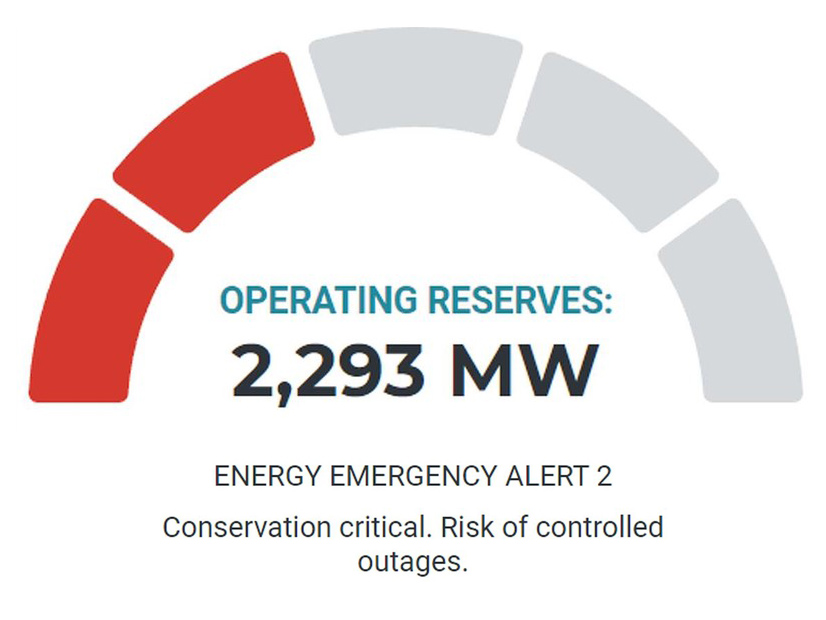DFW AIRPORT, Texas — A frequency drop Wednesday evening leading to a dip in operating reserves forced ERCOT to enter emergency operations for the first time since the disastrous February 2021 winter storm.
The EEA 2 was issued to maintain critical system frequency because of low power reserves. Grid frequency is the balancing of the flow of electricity between 60.1 Hz and 59.9 Hz and must be maintained at that level on the entire ERCOT grid. Thursday night, the frequency dipped to 59.77 Hz.
The grid operator issued a Level 2 energy emergency alert at 7:26 p.m. CT when operating reserves dropped below the 2,300-MW threshold as solar energy ramped down during near-record peak demand. It said frequency dipped to 59.77 Hz, below the 60.1-59.9 Hz critical system range; the EEA allowed ERCOT to use additional reserve resources.
“To protect the stability of the electric system, ERCOT has access to additional reserve sources only available during emergency conditions,” CEO Pablo Vegas said in a press release.
In its first public acknowledgement of the event, ERCOT said in a Thursday evening email to the media that the event was triggered by a transmission limitation that restricted the flow of generation out of South Texas to the rest of the grid.
ERCOT exited the Level 2 EEA about an hour and 15 minutes later, dropping down to Level 1. Operations returned to normal about 10 minutes after that.
Wholesale prices spiked at $5,070/kWh during the alert after having ranged from $20 to $60/kWh earlier in the day.
Speaking at SPP’s Resource Adequacy Summit at Dallas/Fort Worth International Airport, Texas Public Utility Commissioner Will McAdams said the commission is compiling a report and it plans to publish Sept. 13. The report will be discussed during the PUC’s open meeting Sept. 14.
“Full debrief, for the public,” McAdams said.
The event occurred during the normal evening period, when the sun sets and, along with it, solar production drops. ERCOT staff have met demand during that time period until Wednesday, when the drop was too precipitous. Solar energy regularly has been providing more than 12 GW this summer, with a peak of 13.73 GW in August.
“A key part of the story is that it’s hotter at 8 p.m. than it used to be,” tweeted Michael Webber, a professor at the University of Texas at Austin leading clean energy technology research. “After more than two months of high temperatures, the streets, sidewalks building materials and soil all become hotter and therefore keep the temps higher for longer after sundown.”
Energy storage contributed a record 2.17 GW of energy during the EEA, according to Grid Status. Generation outages were within ERCOT’s normal expectations of 5 to 6 GW.
“We need more dispatchable capacity to cover those time frames where our tightest timeframe isn’t even in the peak demand time of the day anymore,” Dan Woodfin, ERCOT’s vice president of system operations, said during a panel discussion at the Resource Adequacy Summit. “We’ve got roughly 13 GW of solar online every day. It’s when the sun goes down and so every day, it becomes an issue of whether the load is going to go down enough, and the wind comes up enough to make up for the solar going down. And it goes down really fast.”
Demand peaked at 82.7 GW on Wednesday, enough to set a new high for September. However, that was far below ERCOT’s still-unofficial peak demand record of 85.44 GW, recorded Aug. 10.
ERCOT issued a conservation appeal at 4:54 p.m. Wednesday for the hours between 6 and 9 p.m. The Texas grid already was operating under a weather watch through Friday, with the state’s largest cities expecting triple-digit temperatures into the weekend.
It made another call for voluntary conservation, its 11th of the summer, for Thursday evening.
ERCOT has called for reductions by large electric customers and has worked with neighboring RTOs to deploy switchable resources. On Thursday, it also requested U.S. Department of Energy authorization to allow its generating units to operate up to their maximum output levels, if needed. The DOE approved the request that day.





